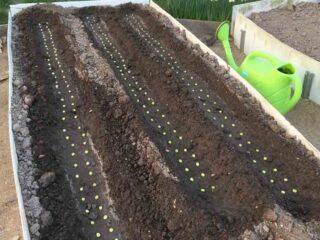Content
The sweetness of the pods and their saturation with nutritional components depends on how often you water the peas. The main condition for the proper cultivation of this legume plant is compliance with the irrigation schedule. It should be remembered that the frequency of watering varies depending on the phase of crop development.
How often to water peas
Without proper moisture, it will not be possible to obtain a high yield of legumes. But peas contain amino acids, protein, dietary fiber and fiber necessary for the growth and development of the body, which ensure the smooth functioning of the gastrointestinal tract.
Frequency of irrigation and amount of liquid per 1 m22 depends on the growth phase:
- Watering peas during planting and before emergence - every week 5-6 l/m2.
- After germination and before flowering, irrigation is carried out once a week. If it is not very hot outside and it rains regularly, there is no need for systematic watering.
- During flowering, the frequency of watering peas is increased to 2-3 times a week. Be sure to take into account weather conditions in the region.
- During the formation of ovaries, the soil is moistened at least twice a week.
- Watering peas during fruiting is carried out every two days.

Peas are an unpretentious but moisture-loving plant.
A sign that it is time to irrigate is the soil. As soon as it begins to dry out, the soil must be moistened. After each watering, the soil should be loosened. Mulching will help reduce the amount of irrigation.
Water temperature and volume
Some gardeners claim that cold-resistant legumes can be watered directly from a hose. But the majority is of the opinion that it is better to moisten the soil with warm, settled water. Tap liquid has a negative effect on the plant, slowing down the growth and development of peas.
Therefore, on the day of watering, you need to fill the watering can with water and leave it in the sun to warm up. If this is not possible, it is recommended to install drip humidification on the site. In this case, the water temperature does not play an important role. While a drop of liquid gets into the soil, it will have time to warm up and will not cause significant damage.
How to water peas correctly
It is impossible to water legumes under strong pressure or from a bucket. The pea root system will be exposed, the plant will become vulnerable to fungal and viral diseases.
Using a watering can
When irrigating from a watering can, the rate of liquid consumption for peas per 1 m2 – 10 l. Choose a strainer with small holes, this will reduce the water pressure.
You can combine the watering procedure with fertilizing. It is recommended to use nitroammophoska. To prepare the solution, dissolve 1 tbsp in 10 liters of water. l. drug. Complex mineral fertilizer can be replaced with mullein solution.
Rules for watering from a watering can:
- After irrigation, there should be no puddles left on the soil. Excess moisture leads to rotting of the roots.
- The bed should be watered in 2-3 doses. No need to try to pour 1 m at a time2 all the liquid intended for it.
- When watering, the spout of the watering can is lowered as close to the soil as possible. Otherwise, under pressure supplied from a great height, the soil will become covered with a thick crust, which will not allow oxygen to reach the roots.
Watering should not be carried out in extreme heat and midday heat. Drops of water exposed to sunlight will burn the plants. In cloudy weather, such restrictions may not be adhered to.
The soil will not have time to shake out, and this is fraught with the appearance of powdery mildew and root rot.
Drip irrigation of peas
The best option for watering peas is drip irrigation. You can purchase the structure at gardening stores or make it yourself. The advantage of drip irrigation is that water slowly enters the soil without damaging the root system. Thanks to this, the culture develops well and quickly.

When adding liquid fertilizers during drip irrigation, their effectiveness and digestibility by the plant increases up to 60%
The gardener has the opportunity to regulate the amount of moisture entering the soil, taking into account the stage of growth of the peas and weather conditions in the region. With drip irrigation, watering can be done at any time of the day. In this case, the likelihood of burns appearing on the surface of the plant leaves is minimal. According to various studies, drip irrigation increases crop yield by 1.5-3 times.
Conclusion
The quantity and quality of the harvest depends on how often and in what way you water the peas.Legumes do not tolerate soil drying out, but overmoistening can lead to the appearance of fungal diseases. To get a good harvest, you should strictly adhere to the watering schedule.








